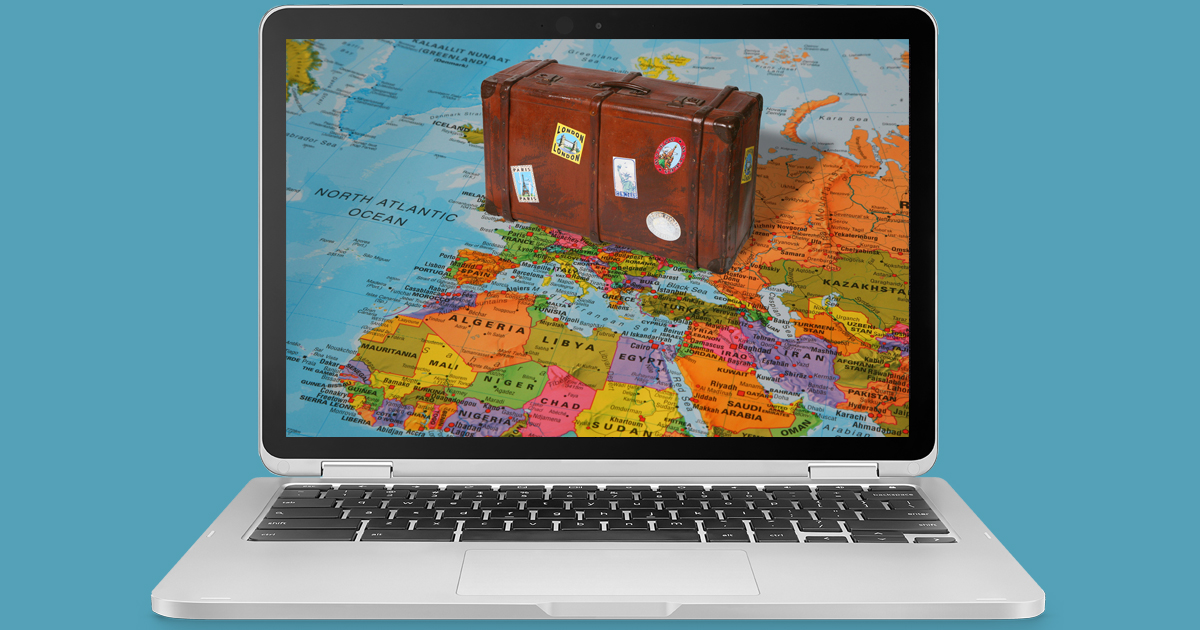
As I boarded my flight from Minneapolis to Warsaw by way of Paris, I was struck with an eerie feeling that this was the first business trip in ten years where I didn’t have my trusty MacBook by my side. Not only was I leaving behind all the technology that I knew (and loved), but I was venturing out into the world with little more than a fleeting hope that I’d manage to be as productive and entertained with my newfound Google Chromebook. Failure to do so would mean I’d spend countless hours in my following weeks catching up on productivity lost. The mere thought of returning to very late nights hunched over my computer answering e-mail upon e-mail upon e-mail gave me pause that maybe this experiment would have been best served upon one of my employees, maybe our Director of Marketing; but as I made my way onboard the Airbus A330, I quietly accepted that I was most likely the best subject for this exact test.
I’m a good test subject because I PACK EVERYTHING. If a normal rational person plans to take a suitcase and a carry-on for their trip, I’m likely to pack two suitcases and two carry-ons for the same trip. I burn through briefcases, messenger bags, tote bags, and backpacks due to the sheer weight of the amount of things I pack. And sack packs, while great as an easy to access carry-on, just aren’t built to house a laptop, power cords, travel itineraries, pens, books, battery backups, portable hard drives, various cables, and on and on and on. I’m also a good test subject because I’ve left bags behind on planes, trains, and shuttles just because I forgot all the items I was carrying at that very moment. In Norway, I forgot a bag on a train that contained both my passport and my wallet. In Las Vegas, I left behind my MacBook on a hotel shuttle. In Minneapolis, I left a shopping bag with presents purchased for my wife and daughter from that week’s work destination. So in order to SIMPLIFY MY LIFE, I decided that I would not only limit myself to one suitcase and one carry-on for Europe; but that, I would shed any additional weight and items not absolutely critical to my travel and slim down to a simple sack pack. Thus, I traded in my Macbook with its bulk and weight and power charger for a lighter and sleeker Chromebook. I was hoping that change wasn’t as hard as advertised.
To help make this experiment more palatable, I pre-loaded my Chromebook with all the essentials and not so essentials for business travel. First, I installed CrossOver on Chrome OS. Full disclaimer, CrossOver on Chrome OS is my company’s software. CrossOver provides the ability to run Windows applications, like Microsoft Office, natively on the Chromebook. And since my work life has been built around Office applications for the past 20 years, it’s somewhat critical, TO ME, to access these documents from any device in my possession regardless of Internet access. After CrossOver, I looked for means to entertain myself. Fortunately, I had a wealth of application options for movies, music, books and audiobooks, games, and even fantasy football. I then downloaded various travel applications to help manage my itinerary and other applications for communicating back to the office, accessing my work calendar, and taking and organizing meeting notes. With my Chromebook loaded and ready to go, I felt that I had put myself in the very best position to succeed in making this experiment work and simplifying my life.
Being productive on a business flight is a stressful challenge. You have limited space with limited tools and limited access to others. As much as I’d like to close my eyes and sleep, I find myself trying to squeeze out e-mails or work on business proposals. Most of the time, this is nearly impossible when trying to balance a laptop on a tray table while trying to access the items you need that are either tucked deep within in the seat back pocket in front of you or in your briefcase in the overhead compartment MORE SO if the passenger in front of you decides to drop their seat in your lap. But upon reaching my seat on the plane, I came to the immediate realization that my Chromebook fit (comfortably) in the seat back pocket in front of me. No need to stash it in the overhead bin or place it below the seat in front of me. In fact because the Chromebook took up so little space, EVERYTHING I wanted I had immediate access to fit in the seatback pocket in front of me: noise cancelling headphones, bottle of water, protein bar, USB-C power cord, even a mouse for the Chromebook. At 10,000 feet, I booted my Chromebook in a matter of seconds and was quickly connecting to the Internet for my e-mail and travel updates. Shortly after receiving coffee service when the passenger in front of me was kind enough to recline his seat into my lap, I was still able to use the Chromebook from the tray table without losing my mind, spilling my hot coffee in my lap, or creating an international incident. And six hours in on the flight when other business travelers were looking for power outlets to charge up their dying laptops, I still had 47 percent battery. The Chromebook was doing its job, and I was feeling that this simplification experiment was creating considerably less stress for me.
Another challenge of business travel is all the walking you do from Point A to Point B. In Paris, I walked nearly 10,000 steps from the arrival gate through security to baggage claim to customs to security (again) to baggage drop off and to the departure gate for my next flight. Walking is not my issue; however, walking 10,000 steps with 60 pounds of luggage and an awkwardly fitting carry-on or two can be a daunting challenge for any business traveler. This is where I was most pleasantly surprised by the Chromebook. Because it weighs almost nothing and could travel in my sack pack, carrying it through the airport was easy. Pulling it out for security checkpoints was easy. Putting it on my back to hoof it to the next stop was easy. And with only one carry-on, I was less likely to forget it (or the sack pack) somewhere along the way. I found the physical handing of the Chromebook to be easy, quick, and convenient which is something my MacBook rarely, if ever, made for business travel.
Upon arriving in Poland and making my way to my hotel room, I found the Chromebook to be of at least similar benefit to my MacBook. The smaller form factor, which was perfect for traveling, made way for some expected limitations in the hotel room. With a 12.3 inch screen and tight keyboard layout, my Chromebook felt a bit cramped on the hotel room desk. Fortunately, the Chromebook has a sister product, the Chromecast, that allowed me to broadcast my desktop to the 42 inch television set in the hotel room. Adjusting my typing style a bit allowed me to type relatively fast on the Chromebook. And plugging a mouse into the Chromebook only made my Chromebook that more useful quickly <clicking> on specific words or menu items. Overall, I was able to make the Chromebook do the things that I needed it to do while in Poland without making the process painful or incredibly time consuming. In fact, I typed out this entire blog on my Chromebook using CrossOver on Chrome OS and Microsoft Word.
And upon returning home, I realized that I would likely continue using my Chromebook for business travel both international AND domestic. I think by leveraging the Google Play Store and further refining the applications I need to use from outside the office that the Chromebook can be even more useful to me. I found the Chromebook to be easy to use, quick to boot up, and made for travel which makes it potentially perfect for business travel. While I was initially skeptical, I ended up very pleasantly surprised with how much I was able to do with the Chromebook compared to my MacBook. But, I should not have been completely surprised by these results; after all, I was probably the best subject for this exact test.
USEFUL TIPS FOR TRANSITIONING TO A CHROMEBOOK:
Tip #1: Know your critical business applications! Whether its Office or Citrix or something in between, you should identify your business critical applications. Then, look to see if these applications are available in the Google Play Store. If not, look for potential alternatives that do roughly the same thing. While Outlook is not available for Android or Chrome, there are several dozen other Outlook clients that allowed me to access and respond to my e-mail. Knowing what you need and becoming familiar with the apps on Chrome OS before you leave the office will save you time and headaches on your business travel.
Tip #2: Understand and accept the compromises! The Chromebook is considerably lighter, has a smaller form factor, a great on-line storage solution (Google Drive), and has a considerably longer battery life. There are also tens of thousands of applications and games that are available in the Google Play Store. However, the Chromebook has limitations. So it’s good to spend time understanding the compromises in changing to the Chrome OS platform.
Tip #3: Don’t be afraid to try new applications! Unlike other platforms, Chrome OS has literally millions of applications in the Google Play Store. This provides ample opportunities to try various applications. For example, I have five different video conferencing applications on my Chromebook. Why? Because I’m testing them out to find the one I like the best. I’m not stuck with only one primary option, and this is true for most all applications. Looking for an e-mail client, there are over 100 e-mail clients available in the Google Play Store (many of them free). Looking for a browser, you can pick from dozens of browsers with a variety of unique features. It’s somewhat liberating to have this much freedom in selecting the applications you wish to use on your Chromebook.
About James B. Ramey
James B. Ramey is the CEO of CodeWeavers. His life long love of video gaming started at the tender age of six with an Atari 2600 and evolved over time to include Nintendo, Super Nintendo, Apple Mac IIc, Windows PC, and MacBook Pro. When not fiddling with technology, James enjoys cooking, travel, debating politics in the office, and spending time with his wife, daughter, and their two rescue dogs. For the past 20 years, James has worked with clients around the world in best implementing technology to maximize a return on their investment. He is a graduate of Moorhead State University and earned his MBA from the University of Phoenix. You can find James on Twitter at @jbramey.

 James Ramey
James Ramey
